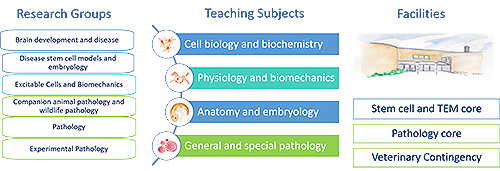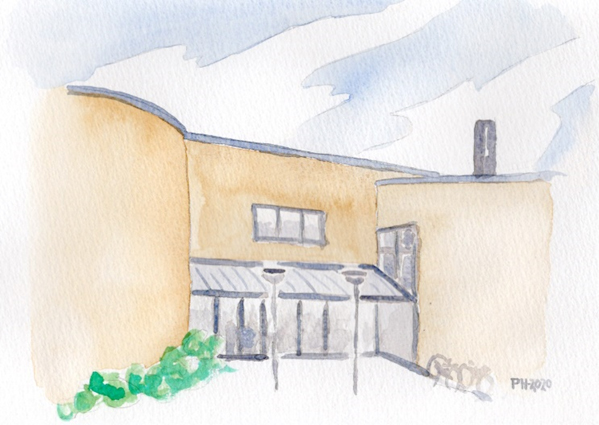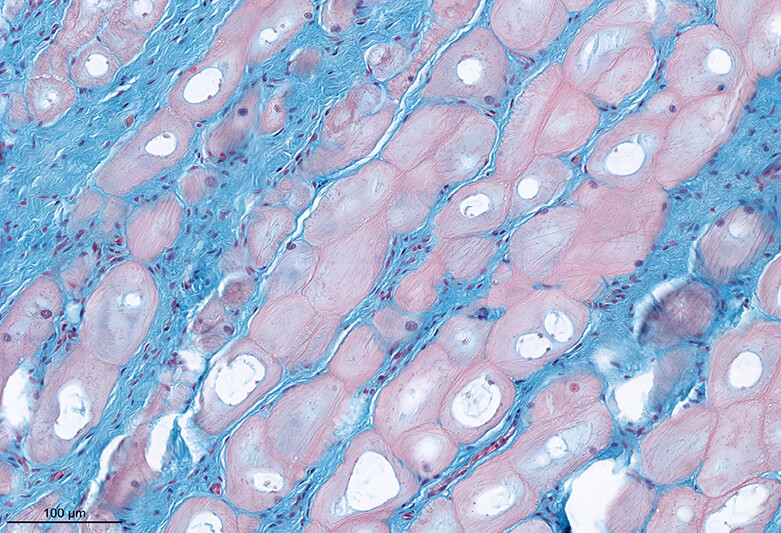Section for Pathobiological Sciences
The section for Pathobiological Sciences (PAS) is a part of the Department for Veterinary and Animal Sciences (IVH) at the University of Copenhagen.

PAS is dedicated to;
-
Research on a high, international level within neuroanatomy, neurodegenerative disorders, electrophysiology, the cardiovascular system, biomechanics, animal welfare, disease models, pathogenesis evaluation, veterinary pathologist diagnostics.
We have established pluripotent (iPSC) stem cells from animals and humans and used CRISPR/Cas9 to develop in vitro models for neuronal and cardiac tissue. We have advanced electrophysiological technics including patch clamp from brain slices, multiple electrodes arrays and bio-impedance recorders. We have developed experimental for testing novel antibiotics ability to prevent biofilm formation on bone implants.
For a more information, please follow the links below.
- Veterinary Contingency, partly consulting cases for the Danish Veterinary and Food Administration, partly veterinary Contingency which receives all cadavers and organs for observation of notifiable animal diseases. Furthermore we are responsible for the surveillance of cattle abortion and the surveillance of TSE (BSE and scrapie) in Denmark.
- Teaching. The teaching of the section is vital to the veterinary bachelor and master programme as well as to the Animal Science programme. We prepare the students for research, diagnostics and clinical work. We educate master students and PhD students on a high, international level within the research areas of the section.
- Students are welcome to contact us for available projects.
Research Groups
The section consists of 6 research groups: Veterinary Pathology, Experimental Pathology, Pathology of small animals and wild life, Disease Stem Cell Models and Embryology, Brain Development and Disease and Physiology.
 Research areas: Animal welfare, lesions and inflammation, animal diseases, diagnostic pathology, comparative infection pathology, fungi, virus, parasite and bacteria infections, animal models, implants, biofilm and alternatives for antibiotics.
Research areas: Animal welfare, lesions and inflammation, animal diseases, diagnostic pathology, comparative infection pathology, fungi, virus, parasite and bacteria infections, animal models, implants, biofilm and alternatives for antibiotics.
- Professor Henrik Elvang Jensen,
- Associate professor Páll Leifsson,
- Associate professor Mette Sif Hansen,
- Assistant professor Kristiane Barington
The research group of Experimental Pathology studies artificially induced, or naturally occurring, pathological processes through macroscopic and microscopic examinations of organs, tissues and cells. The vision is to reveal and visualize disease mechanisms of both human and animal diseases and, thereby, contribute to development of new diagnostic, prognostic, prophylactic and therapeutic technologies. Our missions are:
- To develop animal models of human diseases and characterize them comprehensively through macroscopic and microscopic investigations.
- To apply animal models of human diseases in diagnostic, prognostic, prophylactic and therapeutic studies.
- To use molecular pathology to identify and investigate disease mechanisms in well characterized animal models, or in tissue samples from animals or humans with a specific natural occurring disease of interest.
Research area: Contingency and notifiable animal diseases, diagnostics of and surveillance of fur animals, wild life pathology and surveillance, gut health and microbiota, wound infections and biofilm in wounds, alternatives to antibiotics (probiotica, wound treatment, selection and immunological toughness).
Research area: Our group is focused on disease modelling using state of the art stem cell approaches for neurodegenerative diseases (Alzheimer’s disease, Frontotemporal dementia, Parkinson’s disease), Epilepsy and Glaucoma. These projects work with human induced pluripotent stem cells (iPSC), CRISPR/Cas9 gene editing neuronal and glial differentiation and downstream analyses in 2D and 3D organoids.
Likewise, we are interested in iPSC models from animals and we are running projects making canine iPSC to understand and make in vitro models of canine cognitive dysfunction as well as making immune-evasive porcine iPSC to improve transplantation studies.
Our research on cerebral vascular (dys-)function in hypertension, aging and obesity/diabetes is focused on their significance as risk factors for several types of dementia, including vascular dementia and Alzheimer’s Disease.
Our focus in embryology is on early events in oocyte and sperm development, reproduction and manipulation of such events to increase life stock sustainability and animal welfare.
 Research areas; We have a shared interest in excitable cells and contractile tissue. The research in this group falls into two main categories: Excitable Cells and Biomechanics.
Research areas; We have a shared interest in excitable cells and contractile tissue. The research in this group falls into two main categories: Excitable Cells and Biomechanics.
Exitable Cells
The molecular basis for the transport of ions, water and nutrients, ion channels, electrophysiology, pharmacological treatment, action potentials, cardiac arrhythmias, epilepsy, migraine, evolution of the electrical signaling in the mammalian heart, stem cells derived organoids
Biomechanics
Fascia, locomotor system, biomechanics, lateral raphe, thoracolumbar fascia, acoustic myography, multi-frequency bioimpedance, isolated tissue bath studies, rheumatology, sports medicine, geriatrics, structural anatomy and pathology
- Associate professor Kirstine Callø,
- Professor Dan Klærke,
- Associate professor Vibeke Sødring Elbrønd,
- Associate professor Adrian Harrison
- Associate professor Jessica Pingel
We have highly specialised Core facilities which perform diagnostic pathology, stem cell technologies.
Pathology CORE
The Histo-Laboratory assists scientists in processing tissue samples for histochemical and molecular based procedures. In the Histo-Laboratory state-of the art histotechnology is offered by a team of specialized technicians.
In research projects, optimal results are obtained when the laboratory is contacted as early as possible in the planning of the in vivo part of the project; allowing the technicians to help determine how histological approach can best support the research aim.
Paraffin embedding, sectioning and staining of tissues. Embedding and sectioning services are based on standard protocols. Tissues are fixed and embedded in paraffin blocks, which are used for a variety of analyses, e.g., histochemical staining (HE, PAS, GMS etc.), immunohistochemistry (IHC), and in-situ hybridization (ISH), PCR, etc. Apart from stained sections, also paraffin blocks and the unstained sections can be provided.
Kontakt: Betina Andersen, bean@sund.ku.dk eller Elisabeth Petersen, ewp@sund.ku.dk. Tlf 35333106.
Veterinary contingency
Contact information:
The veterinary contingency - phone number 9350 9280 - can be contacted 8:00-16:00 on working days.
Non urgent inquiries can be mailed to: kupat@sund.ku.dk
Contact person: Anne- Sofie Hammer, hammer@sund.ku.dk
Stem cell and TEM core
Anubis Core
Employees at Section
Internal researchers
| Name | Title | Phone | |
|---|---|---|---|
| Aldana, Blanca Irene | Associate Professor | +4531541804 | |
| Ameen, Aisha | Research Assistant | +4535334906 | |
| Andersen, Betina Gjedsted | Biomedical Laboratory Scientist | +4535336737 | |
| Andersen, Frederik | Attendant FU | +4535336735 | |
| Andersen, Maja Hauptmann | Research Assistant | +4535328385 | |
| Andersen, Katrine Bülow Randløv | Teacher´s Assistant | +4535328918 | |
| Andersen, Sofie Amalie Flintholm | PhD Fellow | +4535328744 | |
| Andresen, Rosa Kirstine | Research Assistant | +4535323761 | |
| Barington, Kristiane | Associate Professor | +4535333112 | |
| Becker, Cecilie Brandt | PhD Fellow | +4535337580 | |
| Birch, Julie Knippel Melsted | Assistant Professor - Tenure Track | +4535334728 | |
| Blirup-Plum, Sophie Amalie | Assistant Professor | +4535331513 | |
| Borup, Hannah Chemnitz | Attendant FU | ||
| Brok, Dennis | Attendant FU | +4535333101 | |
| Buchmann, Kurt | Professor | +4535332700 | |
| Bækgård, Cecilie | PhD Fellow | +4535326909 | |
| Callø, Kirstine | Associate Professor - Promotion Programme | ||
| Christiansen, Lise-Lotte | Laboratory Technician | +4535332747 | |
| Duan, Yajiao | Postdoc | +4535325382 | |
| Dyre, Røsle Elisabeth | Teacher´s Assistant | ||
| Egholm, Niels Jákup | Attendant FU | +4535333884 | |
| Eiersted, Anna Cecilie Boldt | Laboratory Technician | +4535337069 | |
| Elbrønd (Bibs), Vibeke Sødring | Associate Professor | +4535332548 | |
| Enevoldsen, Sara | PhD Fellow | ||
| Fenner, Merle Friederike | Guest Researcher | +4535333300 | |
| Flyger, Christoffer Kirkelund | PhD Fellow | ||
| Francia, Luca | Teacher´s Assistant | ||
| Frederiksen, Henriette Reventlow S | Postdoc | +4535336165 | |
| Freude, Kristine | Professor | +4535330937 | |
| Gelskov, Sara Vebæk | Academic Research Staff | +4522877969 | |
| Goncalves Bessa, Rita | PhD Fellow | +4535333898 | |
| Gulmann, Adam | PhD Fellow | ||
| Hald, Jonas Laugård | PhD Fellow | +4535328983 | |
| Halgirsson, Brandur | Teacher´s Assistant | ||
| Hammer, Anne Sofie Vedsted | Associate Professor | +4535333129 | |
| Hansen, Mette Sif | Associate Professor | +4535326468 | |
| Hansen, Vibeke Bøgelund | Attendant | ||
| Hansen, Charlotte | Teacher´s Assistant | ||
| Hansen, Line Sofia Nordahl | Teacher´s Assistant | ||
| Harrison, Adrian Paul | Associate Professor | ||
| Hartmann, Katrine Top | Research Assistant | +4535331206 | |
| Haulund, Marie Louise | Attendant FU | +4535334925 | |
| Henard, Cyril Pierre Frederic | Research Assistant | +4535323641 | |
| Henriksen, Nicole Lind | Postdoc | +4535336506 | |
| Hildebrandt, Sally Xin | Laboratory Technician | +4535329941 | |
| Holm, Peter | Associate Professor Emeritus | +4535332885 | |
| Hydeskov, Helle Bernstorf | Assistant Professor | +4535328601 | |
| Høeg, Frederikke Juncher | Research Assistant | +4535321518 | |
| Imran, Fareeha | Visiting PhD Student | ||
| Iversen, Bolette Margrethe Nyvang | Visiting Student | ||
| Jaafar, Rzgar | Attendant FU | +4535333137 | |
| Jakobsen, Emil D.T. | Laboratory Technician | +4535327693 | |
| Jensen, Louise Kruse | Professor | +4535336192 | |
| Jensen, Betina Wingreen | Special Consultant | +4535334704 | |
| Jensen, Jan Lykke | Attendant | ||
| Jensen, Henrik Elvang | Professor | +4535333100 | |
| Jensen, Lars Jørn | Associate Professor | +4535332563 | |
| Jensen, Hannah Malene | Guest Researcher | +4535334790 | |
| Jensen, Anne Majgaard | PhD Fellow | +4535328540 | |
| Jensen, Dennis Schultz | Attendant | ||
| Jensen, Tim Kåre | Senior Adviser | ||
| Jepsen, Milla Cecilie | Laboratory Assistant | +4535331779 | |
| Jørgensen, Louise von Gersdorff | Associate Professor | +4535332769 | |
| Jørgensen, Mads Neergaard | Teacher´s Assistant | ||
| Kadlecová, Marion | Research Assistant | +4535332030 | |
| Karami, Asma | Postdoc | +4535337095 | |
| Klein-Ipsen, Pernille | PhD Fellow | +4535329678 | |
| Klærke, Dan Arne | Professor | +4535332511 | |
| Kromann, Sofie | Assistant Professor - Tenure Track | +4535326918 | |
| Kumas, Kaan | Research Assistant | ||
| Lausten, Marie Sandholdt | Teacher´s Assistant | +4535329738 | |
| Leifsson, Páll Skúli | Associate Professor | +4535333114 | |
| Lindberg, Lucas Alexander | Teacher´s Assistant | +4535324987 | |
| Lübbers, Nanna Sand | Research Assistant | +4535337667 | |
| Madsen, Henry | Emeritus | ||
| Marana, Moonika Haahr | Assistant Professor | +4535333127 | |
| Mathiessen, Heidi | Postdoc | +4535335452 | |
| Mejer, Helena | Senior Adviser | +4535332789 | |
| Menezes, Niels Alvaro | Guest Researcher | ||
| Mohamed, Fadumo Abdullahi | Research Assistant | +4535325198 | |
| Nielsen, Andreas Kalis Kamper | Attendant FU | +4535327829 | |
| Nørgaard, Laura Marqvard | Teacher´s Assistant | ||
| Oskarsson, Chichi N. | Laboratory Technician. | +4535332288 | |
| Ove, Helene Simmelkjær | Attendant FU | +4535330569 | |
| Ovesen, Maibritt Træholt | PhD Fellow | +4535330362 | |
| Pan, Geng | PhD Fellow | +4535329241 | |
| Pedersen, Amalie Camilla | Research Assistant | +4535323865 | |
| Pedersen, Meline Bella | Teacher´s Assistant | ||
| Peterlin, Anton Alexander Nolte | PhD Fellow | +4535329486 | |
| Petersen, Elisabeth Wairimu | Laboratory Technician | +4535336757 | |
| Petersen, Natasha Silijae Drejer | Teacher´s Assistant | ||
| Quaade, Michelle Lauge | Postdoc | +4535334685 | |
| Ralbovszki, Dorottya Maria | External, Ph.d Student | +4535325434 | |
| Rosengren, Laura Bjerre | Teacher´s Assistant | +4535333508 | |
| Rotovnik, Rosalina Molberg | PhD Fellow | ||
| Saruhanian, Sarkis | External, Ph.d Student | +4535327472 | |
| Sathya Narayanan, Udhaya Bhaskar | Postdoc | +4535329690 | |
| Schelde, Ellen Sofie | Teacher´s Assistant | ||
| Schou, Sofie Kalum | Academic Research Staff | +4535335211 | |
| Sengupta, Mita Eva | Assistant Professor | +4535331418 | |
| Severin, Natacha Leininger | PhD Fellow | +4535328828 | |
| Sharma, Mona | Postdoc | +4535334846 | |
| Stensgaard, Anna-Sofie | Associate Professor | +4535336588 | |
| Storm, Amanda | Teacher´s Assistant | ||
| Tao, Ruixin | Research Assistant | ||
| Thamsborg, Stig Milan | Professor | +4535333778 | |
| Thiesgaard, Liv Carolina Wichmann | Teacher´s Assistant | ||
| Thomsen, Preben Dybdahl | Emeritus | +4535332545 | |
| Tornager, Nynne Maria | Attendant FU | +4535332643 | |
| Upfold, Jennifer Kate | Guest Researcher | ||
| Vedsted-Jakobsen, Amalie | PhD Fellow | +4535329726 | |
| Vennervald, Birgitte J | Professor | +4535331440 | |
| Wathikthinnakon, Methi | Postdoc | ||
| Westfall, Jesse James | PhD Fellow | +4535323550 | |
| Williams, Andrew Richard | Professor | +4535332797 | |
| Williams, Emilie Danielle Madsen | Laboratory Assistant | +4535334392 | |
| Zhang, Xiaoyu | Visiting Student | ||
| van der Deure, Tiem | PhD Fellow | +4535333615 | |
| von Münchow, Alexandra Soraya G L | PhD Fellow | ||
| von Spreckelsen, Alexander | PhD Fellow |

